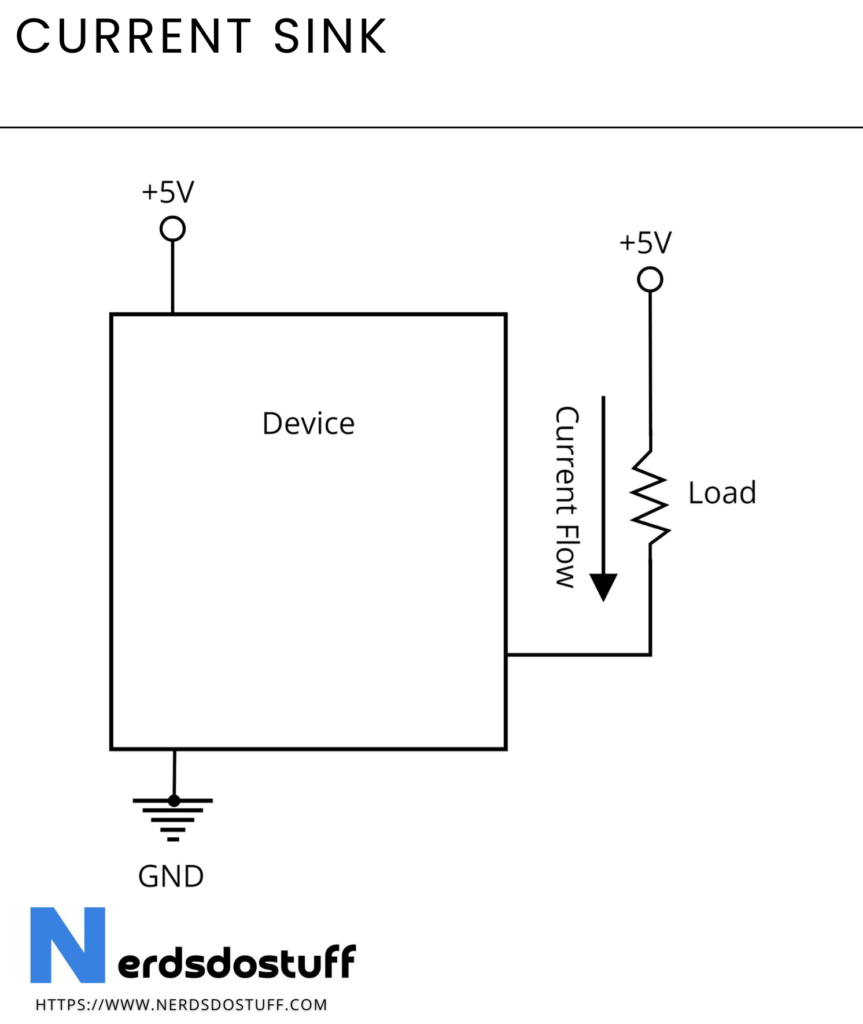What is Current Sink?
A current sink refers to a circuit or device designed to draw or sink electrical current from a connected circuit. In other words, it acts as a load that absorbs or consumes current. Current sinks are often used in electronic circuits to control or regulate the amount of current flowing through a specific component or part of the circuit.
The opposite of a current sink is a current source, which provides or sources electrical current to a circuit. Current sinks find applications in various electronic systems, such as in transistors, operational amplifiers, and other components where precise control of current is essential for proper operation. They are employed in situations where it’s necessary to maintain a stable current level or to create a specific voltage drop across a load.
Current Sink Circuit Diagram

A current sink circuit is a configuration designed to draw or sink a specific amount of electrical current from a connected circuit. It is commonly used in electronic circuits for various purposes, such as biasing transistors, setting reference currents, or controlling the brightness of LEDs. The key feature of a current sink circuit is its ability to maintain a relatively constant current flow despite variations in the input voltage or other factors.
Circuit Explanation:
- Device (Unknown): You have a device in your circuit, and it is not clear whether it’s a load or a source. Let’s assume it’s a load for now.
- +5V Connected to Device: This indicates that the positive terminal of a 5-volt power supply is connected to your device. The device could be a component or a module that requires power to operate.
- GND Connected to Device: The ground (0V reference) is connected to the device. Ground serves as the reference point for the circuit’s voltage levels.
- +5V Connected to Load: On the right side, you have another connection from the +5V supply going to a load. The load is a component or set of components that consume electrical power.
- Load Connected to Device: The load is connected to the device, forming a circuit loop. Depending on the characteristics of your device, it may be sourcing or sinking current.
- Current Flow Towards the Device: You mentioned that current flows toward the device. In a current sink configuration, this typically means that your device is acting as a sink, drawing current from the +5V supply.
Working of Current Sink
A current sink is a circuit configuration that relies on a transistor as its primary component for controlling the flow of electrical current. This transistor, often a bipolar junction transistor (BJT) or a field-effect transistor (FET), plays a pivotal role in regulating the current within the circuit. The input signal, applied to the base of a BJT or the gate of an FET, determines the transistor’s conductivity and, consequently, the amount of current flowing through the circuit.
In a typical setup, the emitter of an NPN BJT or the source of an N-channel FET is connected to the ground, establishing a reference potential. This configuration ensures a baseline for the circuit’s voltage levels. Meanwhile, a load resistor is situated between the collector (for BJT) or drain (for FET) and the power supply voltage. This resistor serves as a crucial element in controlling the current flow within the circuit.
When the input signal activates the transistor, it creates a low-resistance path between the collector (or drain) and the emitter (or source). This action enables the flow of current through the load resistor, effectively forming a current sink. The ability to precisely regulate this current flow is vital in applications where maintaining a stable and controlled current source is essential.
Regulation and control are achieved by adjusting the input signal or modifying the biasing of the transistor. This level of control is particularly useful in electronic circuits where stability and precision in current management are critical. Common applications of current sink circuits include biasing circuits and scenarios where a constant and controlled current is required, such as in driving components like LEDs to maintain a consistent brightness level.
Applications of Current Sink
- LED Dimming: Current sink circuits are frequently employed in LED (Light Emitting Diode) dimming applications. LEDs operate optimally when driven with a constant current. Current sink circuits can be utilized to regulate the current flowing through the LED, allowing for precise control over the brightness levels. This is essential in applications such as mood lighting, display panels, and energy-efficient lighting systems.
- Biasing Transistors: In electronic circuits with transistors, maintaining a stable bias current is vital for proper transistor operation. Current sink circuits are often used in biasing networks to establish a consistent current flow through the base of a transistor. This ensures that the transistor operates in its active region and contributes to linear signal amplification in applications like audio amplifiers and RF circuits.
- Reference Current Sources: Current sink circuits can serve as reference current sources in precision electronic systems. These applications often require a stable and well-controlled current for accurate measurements or as a reference point for other circuit components. Current sink circuits provide a reliable means of generating a known and constant current, making them suitable for applications like analog-to-digital converters (ADCs) or sensor interfaces.
- Motor Control: In certain motor control applications, it is essential to regulate the current supplied to the motor coils. Current sink circuits can be incorporated to control the current flow through the motor windings, ensuring precise and controlled movement. This is commonly used in robotics, industrial automation, and other applications where accurate motor control is critical for performance and efficiency.




